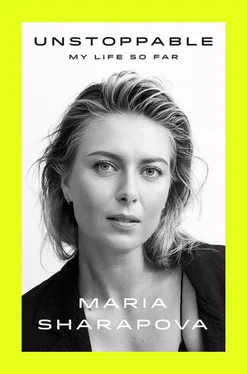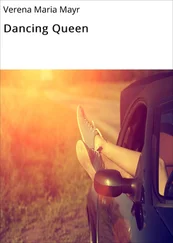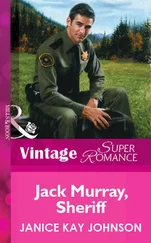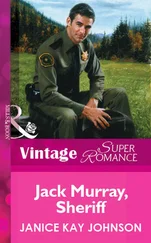It came by text—not exactly a handsome rider on a handsome steed carrying a golden scroll, just a few words that popped onto the screen of my phone. It was from someone at the Russian Tennis Federation. It mentioned the upcoming Summer Olympics in London, then asked if I’d be interested in carrying the flag for my country in the opening ceremony, leading the Russian athletes into the arena as the whole world watched, standing for and representing my country.
At first, I thought it was a joke. At first, I think everything is a joke, especially if it comes from the Russian Tennis Federation. There’s no way! No fucking way! Someone is teasing me, making sport of me. I showed it to my mother. She read it over carefully, then read it again through narrowed eyes. Handing back the phone, she said, “Well, Masha, this seems to be pretty real.”
As soon as she said that, I got the chills. Goose bumps.
It turned out to be one of the greatest honors of my career. I was the first woman to ever be given that honor by Russia, so it was a bit of a controversy. When they came to fit me for the outfit—a burgundy coat, wide-legged trousers—I could not stop smiling. You can go back and look at footage of the event itself. I am walking in front of four Russian men who wear blue coats and Panama hats. Behind them, the rest of our team, in burgundy coats, smiles and waves. I wear a straw hat of my own, and I cannot stop grinning. As we walked, all I could think about was watching the Olympic opening ceremony as a little girl. I wore a white beret, and walked circles around my bed, as if I were one of the athletes in the parade on TV. And now I was really here.
The Olympic matches were played in Wimbledon, which—well, you know how much I love that place. I made it all the way to the final, which was played on Centre Court on a windy day. I was beaten—I won only a single game!—in the final by Serena Williams. Of course, I’d like to have performed better. For myself, and for my country. But the story seemed to be less about Russia and America than about me and Serena Williams. What’s going on? A player can beat Serena, and I can beat that player, but I don’t beat Serena herself. My career record against Serena? It’s not pretty. I’ve beaten her only twice, both times before my shoulder surgery. Of course, a lot of that lopsided record is explained simply by her excellence as a player. Her game—her serve and power, her ability to move her opponent from side to side—matches up well against mine. Serena’s strengths are like puzzle pieces that snap into my weaknesses. And then there’s my serve—when I lost that first serve, I lost a serious weapon. Maybe it gave her the edge. Yet that cannot be the whole story. There must be something else at work, there just has to be. I think Serena has an extra motivation when she plays me. She wants to beat everyone, but she wants to beat me more. Why? Because I beat her at Wimbledon when I was a kid. Because I took something from her, that first flush, which you can never really get back. Because I happened to walk into the clubhouse at exactly the wrong moment and so heard her crying and witnessed her low and vulnerable moment. And I don’t think she’s ever forgiven me for it.
I stood on the platform after the final, staring straight ahead, as Serena was covered in gold. A moment earlier, I had been given the silver medal. Silver is beautiful, but silver is not gold. I had only a single thought in mind: I will get her back at the Rio Olympics in 2016. Of course, that wouldn’t happen.
That’s the last part of my story.
I’d had several coaches in the course of my career.
My coaching days with Thomas Högstedt were coming to an end in the summer of 2013. That year’s Wimbledon was our last tournament together. Thomas came in at the perfect time in my career. He got me motivated after shoulder surgery. Brought back so much energy to my practices that I began looking forward to practice instead of dreading the constant repetitions, same drills, nonstop. But off the court? The most challenging individual I have ever worked with. But I couldn’t focus on that, because what he was bringing on the court outweighed everything else, and one of my greatest strengths was knowing how to separate the unnecessary from what really matters. Until I just couldn’t. I had to stop working with him. Abruptly. It felt like the right decision until I realized I would have no coach and didn’t know or couldn’t think of anyone else.
Max sent me a list of possible coaches. I grimaced at everyone on that list, until I saw Jimmy Connors on the bottom of it. I liked it. Was this even an option? Max called his manager. Jimmy was interested, but his interest came with a very expensive price tag. I had never seen numbers or bonuses like that for a coach. I knew that Andy Roddick had worked with him previously. Was Andy paying him that much money? I never found out. But I didn’t have other options, so within days it felt like Jimmy had my bank information for unlimited withdrawals. He would drive down every day to L.A. from Santa Barbara. I offered him a hotel room so he didn’t have to drive, but he said he liked listening to the radio. It must have been a good station because he spent more than five hours a day driving back and forth.
What I thought would be the same experience as back in 2007 was completely the opposite. The difference was that Michael Joyce was no longer leading practices. Jimmy was. There was no structure, no thought-out plan for the practice, no particular drills or things we would work on. I would hit in the center of the court for hours at a time. No patterns, nothing. He said to make sure I didn’t let any ball get by me, no matter if it’s in the court or not. He did this drill where he would stand with a basket of balls at the corner of the net and basically play fetch with me. He would feed the ball high and loopy toward the baseline, and I would have to run to it, catch it with my hands, and bring it back to the basket. Endlessly. Until I couldn’t run any longer.
I thought maybe this was just the beginning, that he was learning about my game, getting to understand me better. But weeks went by, and nothing had changed. The moments I enjoyed most were during water breaks, when he would talk about his career, his experiences, what his mom was like, his mentality. All the things that had nothing to do with my game. And that was the problem. This was one of the very few times in my career where I would drive to practice feeling miserable. I remember it so clearly: it would be around 9:00 in the morning, I’d be pulling up to the country club tennis courts, and in my gut I would know it wouldn’t work out. I called Max. I was holding back tears and cried as I got off the phone. I told him I didn’t think this was going to work. Max asked me to give it some time, things would fall into place. That I would understand Jimmy’s structure, his way of communicating. I knew Max was wrong. But I also knew I didn’t have any other options at the time so I was going to have to suck it up.
We had already announced our partnership, and our first tournament together was going to be in Cincinnati. I met Jimmy at the airport; he came to the check-in desk wearing old-school faded blue jeans and a cream sweater vest. He carried a large suit bag. He mentioned he liked to watch matches wearing button-down collared shirts and suit jackets. I didn’t know he packed them so well. He said all the other coaches in their track suits and baseball hats looked like clowns. I wasn’t used to that attire, but if he wanted to dress the part in the stands, I didn’t really care.
Arriving at our first practice together at the tournament felt very uncomfortable. Everyone watched our every move. Fans shouted both our names at the end of each practice. Jimmy waved and signed autographs. It felt like being part of a circus act when all I wanted was to do my work on the court, take some pictures, sign a few autographs, and quietly slip out the back door. With Jimmy, it felt like so much more.
Читать дальше












